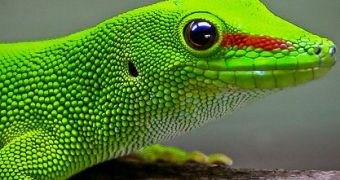A new research carried on by Kellar Autumn and his team, explained why gecko's feet are so sticky and also how humidity helped them have a good grip.
Humans are trying to make ever more advanced glues, for different kinds of surfaces, but they will never surpass geckos and their sticky feet.
Geckos can climb on to anything, even the smoothest surfaces, and they have a secret weapon: their self-cleaning microscopic spatula-shaped hairs, called setae, that coat the soles of their feet.
Eight years ago, Kellar Autumn discovered that these dry hairs adhered so well to surfaces, that geckos stayed 'glued' by van der Waals forces only.
Further studies have suggested more recently that humidity helped geckos stick even better, thanks to the capillary action carried out by minute droplets between the setae and the surface.
These studies have determined Autumn and his team to see for themselves if the phenomenon was true or not, so they started experimenting in their lab at Lewis and Clark College and the University of Washington, USA.
Geckos replace the setae they lose when moulting, so Autumn, postdoctoral student Jonathan Puthoff and Matt Wilkinson gathered patches of sticky setae and tested them on 'Robotoe'.
This mechanic device reproduces the way that reptiles drag their feet when in contact with a surface, and the researchers tested two different surfaces, one that attracted water and another that repelled it.
They also accounted for different speeds and environments – from 10% to 80% humidity, and saw whether the microscopic water bridges that formed in a very humid environment helped geckos hang on.
But their water bridges theory was wrong, as the setae's adhesion and friction were basically the same on the two surfaces, and slower or faster movements made no difference whatsoever.
After concluding that geckos did not use water bridges to get a better grip, graduate student Michael Prowse insisted they should investigate further, and look at the reptile's feet.
The setae are made out of keratin, which is softened by high humidity, so Autumn thought that the softer setae could improve the contact with surfaces and increase the van der Waals adhesion.
So the researchers started measuring the softness of the setae at different degrees of humidity, and a mathematical model built by Puthoff proved that a softer, more deformable setae explains the gecko's enhanced attachment.
Humidity not only increased the adherence, it also allowed the reptile to peel its foot off more easily.
Autumn's team discovery is publisehd today, October 15, 2010, in The Journal of Experimental Biology.

 14 DAY TRIAL //
14 DAY TRIAL //